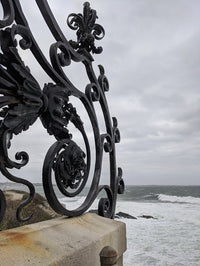Keeping wrought iron clean is essential if you want to keep it in top condition for years to come. Trust me, I’ve seen beautiful ironwork go from stunning to shabby just because it was neglected. Regular cleaning not only removes dirt and grime but also helps prevent rust and corrosion from taking hold. Think of it like giving your ironwork a little TLC—show it some love, and it’ll keep looking great and standing strong through all kinds of weather.
Does the Cleaning Method Change for Wrought Iron, Black Metal, or Regular Metal Railings?
Absolutely, cleaning methods can differ depending on the type of metal you’re working with. Wrought iron, for instance, has a rougher, porous surface that tends to hold onto dirt and moisture, making it a bit more high-maintenance. You want to stick to mild soap and a soft brush to avoid damaging the finish, and sealing it afterward is a must if you don’t want to see rust rearing its ugly head.
Black metal railings, on the other hand, are usually powder-coated steel or aluminum, which makes them more resistant to rust and easier to clean. A quick wipe-down with soapy water usually does the trick, and if you want to go the extra mile, a layer of wax will keep them looking sleek and shiny.
When it comes to plain metal railings—whether they’re aluminum, steel, or stainless steel—the approach can vary. Stainless steel, for example, doesn’t rust but can get water spots or light stains that need a special cleaner. With aluminum or steel, you might need to keep an eye out for oxidation or rust spots.
So, while the basics are similar, the products and level of care can change depending on what you’ve got on your hands. It’s all about knowing your metal and giving it the right kind of love and care.

Tools and Products for Cleaning Wrought Iron and Metal Handrails
Having the right tools and products is the key to cleaning different types of handrails effectively—using the wrong ones can lead to scratches, discoloration, or even damage. From my experience, it’s all too easy to grab a harsh cleaner and end up regretting it later. Here’s a quick rundown of what you’ll need:
- Mild Soap or Detergent: Gentle enough to clean the surface without stripping any paint or finish.
- Soft-Bristled Brush or Sponge: Perfect for scrubbing away dirt and grime without scratching the metal.
- Water Hose or Bucket: Helps rinse away soap and dirt, leaving a clean surface.
- Microfiber Cloth or Towel: Ideal for drying and preventing water spots.
- Stainless Steel Cleaner and Polish: It’s formulated to remove fingerprints, water spots, and minor stains without scratching or damaging the surface.
- Rust Remover: For tackling any minor rust spots without damaging the surrounding area.
- Protective Wax or Sealant: Seals in your hard work and keeps moisture out.

Step-by-Step Guide to Cleaning Wrought Iron
Cleaning wrought iron doesn’t have to be a daunting task. I like to break it down into a simple 3-step method: Surface Cleaning, Deep Cleaning, and Post-Clean Protection.
Step 1: Surface Cleaning
Let’s start with Surface Cleaning: First, grab a soft cloth or a brush and go over the entire piece to remove any dust, loose dirt, or cobwebs. This step is essential because you don’t want to be scrubbing mud into the surface later. If it’s a painted piece, handle it with care—no need to scratch or chip the paint when a light sweep will do the trick. For outdoor pieces, you might want to give it a quick rinse with a hose to clear away any surface grime before moving on.
Step 2: Deep Cleaning
Next up is Deep Cleaning: mix some mild soap with warm water and use a soft-bristled brush to gently scrub down the wrought iron. Unpainted surfaces can handle a bit more pressure, but for painted or decorative pieces, stick to gentle strokes to avoid damage. Got ornate details or tight spots that a normal brush can’t reach? That’s where an old toothbrush comes in handy—it’s perfect for getting into those nooks and crannies without causing harm. For really tough grime, let the soapy solution sit for a few minutes to loosen it up before scrubbing.
Step 3: Post-Clean Protection
Finally, the last but crucial step is Post-Clean Protection. Dry the entire piece thoroughly using a microfiber cloth—this is super important, as leaving water behind can lead to rust forming. Once it’s completely dry, apply a layer of protective wax or a clear metal sealant, especially if your wrought iron is exposed to the elements. This creates a barrier that keeps moisture out and prevents rust. For painted wrought iron, a fresh coat of paint can act as both protection and a little cosmetic touch-up. This last step is the key to keeping your ironwork looking as good as the day you got it, no matter the weather.
Rust and Stubborn Stains Removal
Removing rust and tough stains from wrought iron requires the right tools and a bit of patience, but it’s completely doable with a few steps. First, gather what you’ll need: a wire brush or sandpaper, mild soap, water, a rust converter, and a protective primer or paint. Start by using the wire brush or sandpaper to gently scrape off any loose rust or flaky paint. Be thorough but gentle—no need to grind away too hard, as you don’t want to damage the metal underneath. Once you’ve removed as much rust as possible, wash the entire area with a mixture of mild soap and water to clean off any remaining dust or debris, then let it dry completely.
Next, apply a rust converter to the affected areas—this is a special product that chemically transforms rust into a stable surface, preventing it from spreading. Let the rust converter sit and do its magic as per the instructions on the bottle, which usually means leaving it for about 24 hours. Afterward, if there are still visible spots, repeat the process until all traces of rust are gone.
Once you’re satisfied with the results, it’s time to protect your hard work. Apply a layer of rust-inhibiting primer to seal the treated area, followed by a high-quality exterior paint if desired. This will not only cover up any unevenness but also keep moisture and rust at bay. Finally, for added protection, consider using a clear sealant over the painted surface.
DIY or Professional Cleaning: Which Should You Choose?
Deciding between DIY and professional cleaning really comes down to the condition of your wrought iron and how much elbow grease you’re willing to put in.
If it’s just a little dusty or has a few spots of dirt, a bucket of soapy water and a brush are all you need. But when rust has taken over or the grime is baked on like a stubborn casserole, it’s probably time to call in a pro. They have the heavy-duty tools and know-how to restore your ironwork without causing damage.
So, if you’re facing a weekend of scrubbing and still dreading the outcome, a professional might just be worth every penny.
Conclusion
In conclusion, a regular cleaning routine and proper maintenance can do wonders for keeping all types of metal handrails—whether it’s wrought iron, black metal, stainless steel, or aluminum—looking beautiful and lasting longer. Routine care helps prevent rust, reduces wear and tear, and preserves the overall appearance of your metalwork. Whether you prefer to tackle the cleaning yourself or call in the pros for a thorough restoration, giving your metal railings the attention they deserve will keep them strong and stunning for years to come. If you ever find yourself facing stubborn rust or more serious issues, don’t hesitate to reach out—we’re happy to help or direct you to the best professional cleaning and restoration services available!
Frequently Asked Questions About Wrought Iron Cleaning
1. How often should I clean my wrought iron or metal handrails?
For general upkeep, it’s best to clean your wrought iron or metal handrails every 3-6 months. However, if they’re exposed to outdoor elements like rain, snow, or high humidity, you may want to inspect and clean them more frequently—every 1-2 months—to prevent rust and dirt buildup.
2. Can I use household cleaners to clean metal handrails?
Yes, but stick to mild, non-abrasive cleaners like dish soap mixed with warm water. Avoid harsh chemicals like bleach or ammonia, as they can damage metal finishes and cause discoloration. For tougher stains, consider using a cleaner specifically designed for metal surfaces.
3. What’s the best way to maintain black metal railings?
Black metal railings are relatively low-maintenance. Simply clean them with soapy water and a soft cloth, then rinse and dry thoroughly. Apply a coat of protective wax every 6 months to keep the finish looking fresh and protected from the elements.
4. Is it better to hire a professional to clean my metal handrails?
It depends on the condition of your railings and your comfort level. If it’s just a routine cleaning, you can handle it yourself with the right tools and products. But if your handrails have extensive rust or require repairs, it’s best to hire a professional who has the right expertise and equipment to restore your metalwork safely and effectively.
5. Can I use a pressure washer to clean metal railings?
Pressure washers can be used on some metal railings, but they should be set to a low pressure to avoid damaging the surface or finish. For wrought iron, it’s generally best to avoid pressure washing, as it can strip away protective coatings and expose the metal to rust. Stick to gentle cleaning methods like soapy water and a soft brush.
6. What’s the best product to seal wrought iron after cleaning?
Use a clear metal sealant or a protective wax specifically formulated for wrought iron. Products like Rust-Oleum Stops Rust or clear polyurethane coatings work well to keep moisture out and prevent future rusting.
7. Can I paint over rusty wrought iron to hide the rust?
Painting over rust without treating it first is not recommended, as the rust will continue to spread underneath. Always remove as much rust as possible, apply a rust converter, and then prime before painting to ensure a smooth, long-lasting finish.









